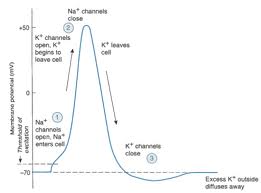Generation and Propagation of an Action Potential
An action potential is a series of events that decrease and reverse the membrane potential and eventually restore it to the resting state. An action potential has a depolarizing phase, the negative membrane potential inside of the cell becomes less negative, reaches zero and then becomes positive. Inflow of sodium ion (Na^+^) causes the depolarizing phase, and outflow of potassium ion (K^+^) causes the re-polarizing phase of an action potential. Once a stimulus has caused the membrane of the axon to depolarize to threshold (- 55mV), voltage-gated Na^+^ channels open and this is like a domino effect, causing more and more Na^+^ voltage gated channels to open bringing the membrane potential from - 55mV to + 30 mV. Also, an action potential has a re polarizing phase in which the membrane potential is restored to -70 mV. Once the Na^+^ voltage gated channels are closed, at the same time the K^+^ voltage gated channels have opened which allows for the flow of potassium inside the cell. The inflow of sodium is slower and the outflow of potassium is somewhat faster which causes the membrane potential to change from + 3- mV to -70 mV. The generation of an action potential depends on whether a particular stimulus is able to bring the resting membrane potential ( -70 mV) to threshold (-55mV). When a particular stimuli is able to bring the resting membrane potential to threshold, an action potential is generated. The action potential arises at the trigger zone and the propagates along the axon and then to a synaptic end bulb where information can be filtered and integrated. As complex as it seems, the human nervous system is what allows us to think, feel, make decisions and is what allows us to learn about the physics that surrounds our lives.


Fig 3.
Illustrates how a specific stimulus brought
the resting membrane
potential to threshold ( -55mv). Image retrieved from http://www.mindcreators.com/NeuronBasics.htm
Fig 2. Illustrates
where nerve impulses are generated and propagated.
Image retrieved from
http://www.abcbodybuilding.com/magazine04/psycho.htm
potential to threshold ( -55mv). Image retrieved from http://www.mindcreators.com/NeuronBasics.htm

Fig 3. Propagation of an Action Potential Animation courtesy of http://wps.aw.com/bc_martini_eap_5/141/36119/9246587.cw/content/index.html
Watch the Propagation of an Action Potential animation